Geek Articles
Fun with Field of Focus II: Copy-to-Copy Variation and Lens Testing

Picture of some damaged pins from a camera's CF board. This has nothing to do with the article except the board is tilted, and the editor yells at me if the article doesn't have a picture. So now it does.
I mentioned in our first post in this series that one of the major reasons I was interested in looking at field curvatures was as a means of detecting lenses that are weaker on one side (or perhaps one corner). If you haven’t looked at that post, you really need to before you tackle this one.
In this post we’ll look a little bit at multiple copies of some lenses and see what kind of things we might see regarding field curvature. The first thing I want to establish is that field of focus for many lenses isn’t perfectly flat like the ideal ones I used in that first post. Just like sharpness and lens aberrations, the field of focus can be tilted a bit.

Picture of some damaged pins from a camera’s CF board. This has nothing to do with the article except the board is tilted, and the editor yells at me if the article doesn’t have a picture. So now it does.
When is it going to be least likely to be tilted? Well, a high-quality prime lens doesn’t have much sample variation, especially if they’re a bit on the telephoto side. So here’s the field of focus for 8 copies of the Zeiss Milvus 85mm f/1.4 lens.
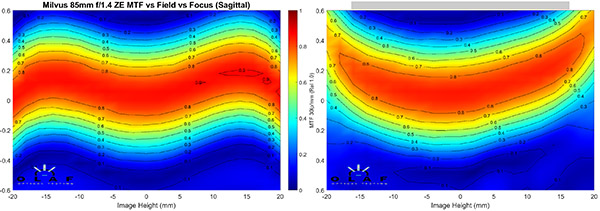
Olaf Optical Testing, 2016
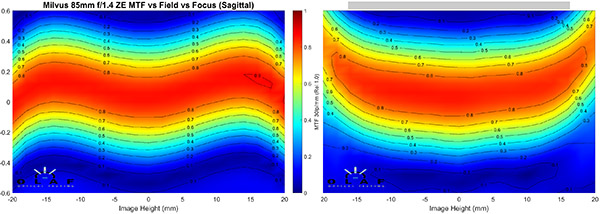
Olaf Optical Testing, 2016
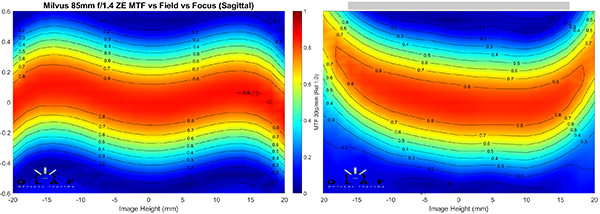
Olaf Optical Testing, 2016
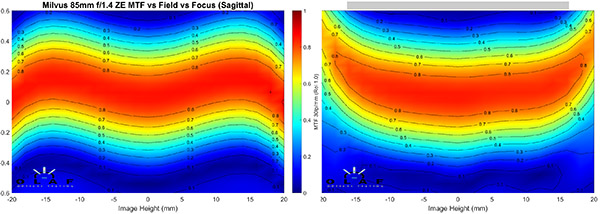
Olaf Optical Testing, 2016
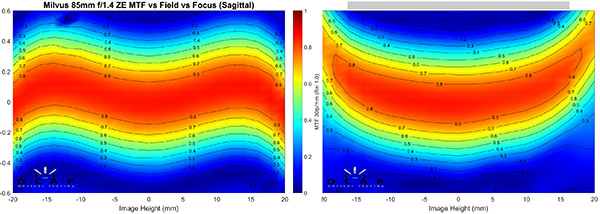
Olaf Optical Testing, 2016
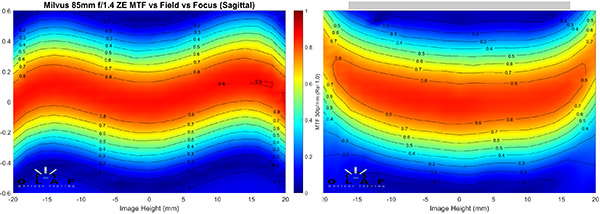
Olaf Optical Testing, 2016
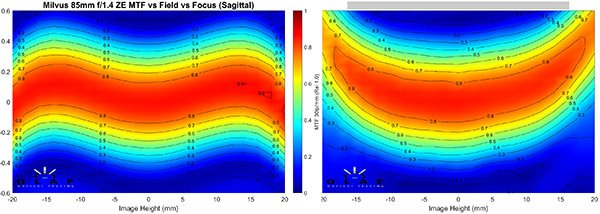
Olaf Optical Testing, 2016
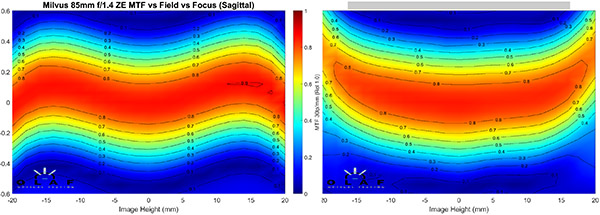
Olaf Optical Testing, 2016
If you look carefully, you’ll see some very slight tilt in a couple of them, but overall they’re pretty flat.
Now let’s look at another 85mm lens, one that’s a very old design and known for a lot of copy-to-copy variation in the sides and edges, the Canon 85mm f/1.8 lens.
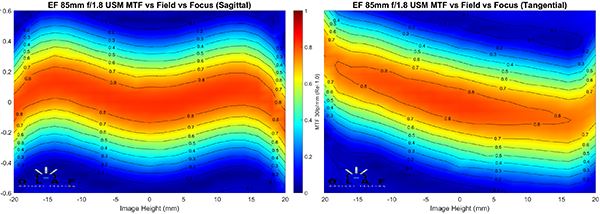
Olaf Optical Testing, 2016
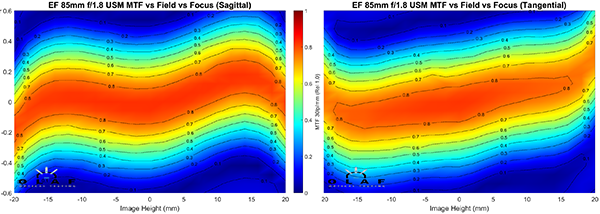
Olaf Optical Testing, 2016
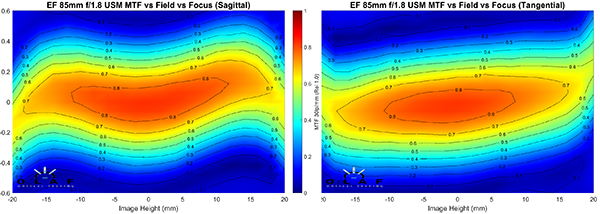
Olaf Optical Testing, 2016
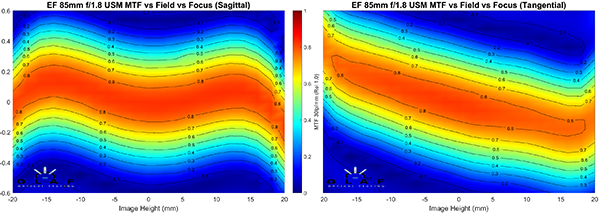
Olaf Optical Testing, 2016
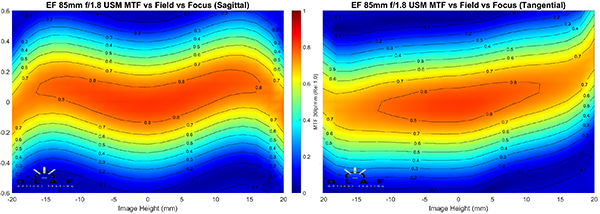
Olaf Optical Testing, 2016
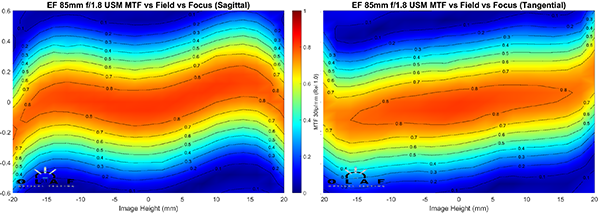
Olaf Optical Testing, 2016
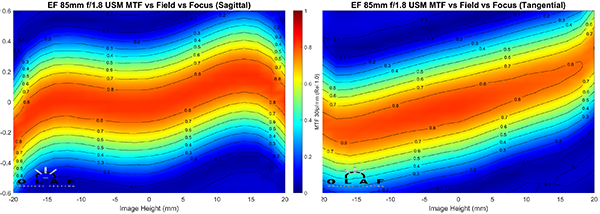
Olaf Optical Testing, 2016
It should be pretty obvious more of these lenses are tilted, and they are more tilted than any of the Milvus lenses were. You may also have noted that in at least some cases the tangential fields are more tilted than the sagittal fields (the first and fourth ones, for example), but most of the time they’re similar.
So What Does that Mean?
Well, first, if you read the first blog post on field of focus, you’ve already realized that if you took, say, a landscape shot with these lenses using center point focus, on one side of the image things closer to you would be in focus. On the other side of the image, things further away than the center point would be in focus.
But the more important part of looking at this is to determine if a lens is a good copy, both for our testing in the lab and for your testing at home. You can tell a lot more about what’s wrong with your lens (if something is wrong) than you do now, and I’ll show you how. But first, we have to get away from the concept that everything wrong with your lens is ‘decentering.’ To help you do so, I shall now rant.
<Rant> Calling everything that’s wrong with a lens decentering is like calling every reason your car won’t start ‘out of gas.’ Posting a picture online with the question “do you think my lens is decentered” is about as useful as posting a picture of a car with the question “do you think my car’s out of gas.” The proper technical term for a lens that is soft on one side is, read this carefully, ‘soft on one side.’ The proper technical term for a lens that is not as sharp as other lenses of its ilk is, to be accurate and technical, ‘not as sharp as other copies.’
If you prefer, just say it’s misaligned. That covers everything. If you don’t know the difference between decentering, tilt, or spacing errors, read this. You probably don’t think you care what type of misalignment the lens has, but actually it makes a big difference, both in whether the service center fixes it right and also what the actual optical effects are on your photographs.</Rant>
In order to get into that a little more, let me remind you that all the field curvatures I’ve been showing you are done at f/5.6. At f/5.6 a lot of the aberrations and defects are gone, the lens has high resolution, and the field of focus is wide. It makes for nice demonstrations about the shape of the curve, but isn’t the best way to test a lens in real life.
Here’s an example showing the difference of a Canon 50mm f/1.2 lens’ field of focus at f/5.6; f/2.8; and finally at f/1.2.
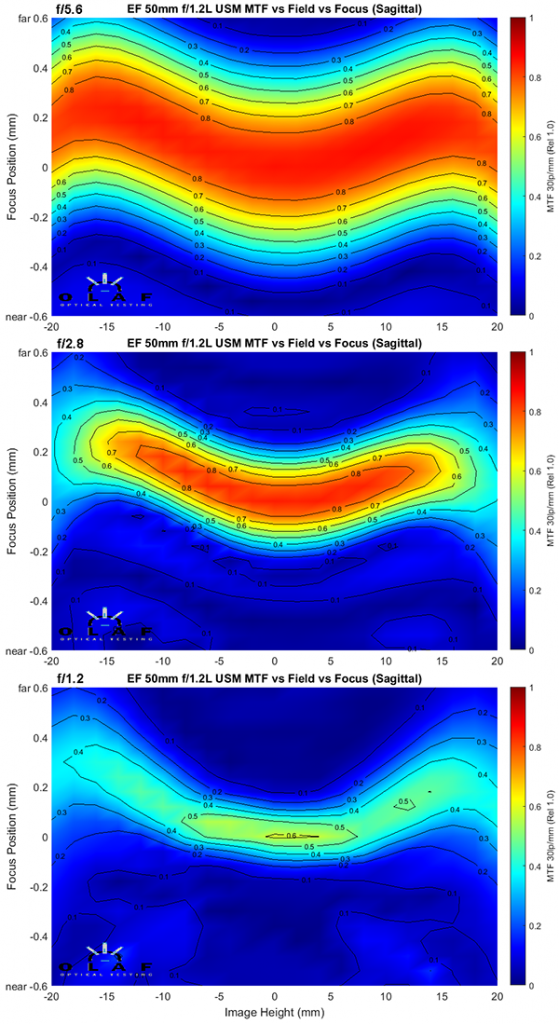
Olaf Optical Testing, 2016
As we opened the aperture from f/5.6 to f/2.8 the depth of field got much narrower. That orange-red sharp area (MTF > 0.8 at 30 lp/mm) isn’t nearly as thick and no longer reaches the far side of the image. At f/1.2, though, there’s no really sharp areas left. The highest resolution is a bit of yellow (MTF > 0.6).
This copy has a tiny bit of tilt that you probably noticed at f/5.6 but it becomes more apparent at f/2.8. (It’s not worse, it’s just more obvious.) At f/1.2 you might also notice that this lens is slightly decentered: the sharpest area is just to one side of the center and the left edge is not quite as sharp as the right edge. Notice that increasing the aperture didn’t change the tilt at all, but only at widest aperture did the other flaws became readily apparent.
This brings up a good question: does decentering cause field tilt? Place your bets now and we’ll do a simple experiment, because science works. We took that copy of the Canon 50 f/1.2 above, loosened the screws that hold the front element in place, and decentered it about as far as we could. Repeating the test above the field of focus graph looked like this.
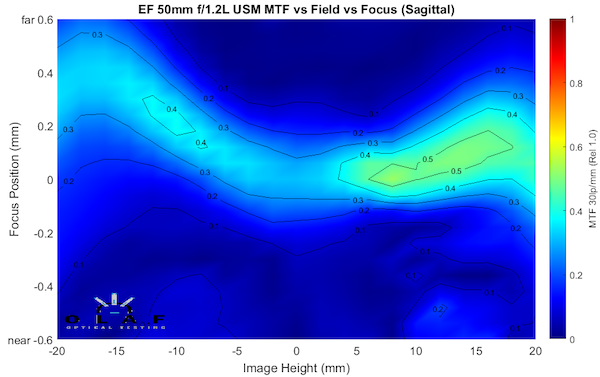
Olaf Optical Testing, 2016
Decentering made the lens less sharp than it was: the yellow area is gone entirely, and the sharpest area has moved far away from center. But the tilt of the field of focus is basically unchanged. So here’s something to note: decentering and tilt of the field-of-focus are NOT the same and not usually caused by the same misalignment. Why do we care? Because they can look very similar on your test-chart photograph, although they’ll look very different in your real photographs.
Field of Focus and Test Charts
Let’s pretend you don’t have your own optical bench, and you’ve just bought a new copy of a lens that you want to check, making sure you got a good copy. So you take it home and take a couple of pictures of your test chart or brick wall and see one edge is softer than the other. Maybe you bought three of that lens them and you find all are a bit softer in one area or another. What does that mean?
Well, really, you don’t know. Most likely you took a hand-held shot and aren’t lined up correctly with the test chart, but since this is pretend, we’ll pretend you were careful enough to set up a perfectly squared shot on a tripod. So now what does it mean? Well, now you know the lens is misaligned, but that’s about it. The lens might be decentered or it might have field tilt. It might have both. I’ll show you how to find out which your lens has, and why it matters.
Remember, your test chart is a flat, 2-dimensional object taking one slice in the 3-dimensional field of focus. Here’s a field of focus curve from one of the 85mm lenses above, with a nice line representing a carefully squared test chart through the center.

If you looked at the image of the imaginary test chart above, you’d notice the center is nice and sharp (yellow area; MTF > 0.6), but at the edges the left side is sharper (MTF >0.4) than the right side (MTF about 0.3). Since you are skilled in the ways of testing, you already have the camera mounted to a tripod and are using live-view focusing (since you know you can’t accurately test the lens’s optics using autofocus). So it’s a simple matter to either 1) move the manual focus back and forth very slightly on the lens taking several shots or 2) get the best possible focus on the softer right side of the chart and take another picture.
Either way, we’ll take a picture that has moved our focus so the chart is in a different part of the field like this one.
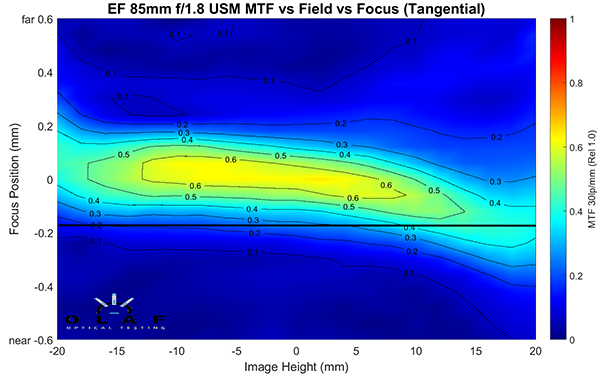
Comparing your two images of the test chart, you’ll quickly realize that the right side is now as sharp as the left side was in the original shot. Your lens is not truly decentered, it has a slight field tilt. This is a simple thing you can check at home: a lens with a little field-of-focus tilt will be about as sharp on one side as the other, but the sharpness will be at different focusing distances. That’s very different, and generally much better, than a decentered lens. (A decentered lens may be sharper on one side, or one corner, or even opposite (diagonal) corners. It will also be softer overall.)
BUT I WANT A PERFECT LENS!!!!!!!!!!!!!!
Of course you do. I want to win the lottery, lose 20 pounds, and have my hair grow back overnight. But except for certain types of photography, a little field tilt doesn’t hurt real-world images nearly as much as it hurts two dimensional test chart or brick wall images. If you’re shooting people, for example, the right, left, and center sides of this lens will all give great images and autofocus will work well. If you’re shooting most landscapes, the focus being a little closer on one side than the other won’t usually matter.
Sure, it could matter if you shoot architectural details or do document reproduction or several other things that require a perfectly flat field. But in most cases, it won’t make much difference. Chances are very high if you hadn’t done a 2-dimensional chart or brick wall tests you would have been quite happy with this lens.
Don’t get me wrong, I recommend doing simple chart or brick wall testing with every new lens because it will detect a truly bad lens that you will not be happy with. But that bad lens is going to stay soft on the edges no matter where your focus it.
Some lenses we’ve tested that have a tilt in almost every single copy. There are a zillion complaints about a soft corner or side in Sony Distagon 35mm f/1.4 lenses, for example; all of the ones we’ve tested have that. BUT, they are often field tilts, not decentering. The lens is as sharp as it should be, but not in a flat plane from side-to-side. Photographer A might find it completely useless, while photographer B thinks the same lens works just great and has no problems with it.
Here’s a good example with another Sony lens, the Sonnar 55mm f/1.8. This is a good copy, nice and sharp and well centered, but with field tilt. If you simply test it on a brick wall or test chart placed at best center focus (as represented by the black line through the “0” focus position) you’d see your chart was clearly softer on one side than the other. If you moved the focus forward a bit, you’d see the soft side was now just as sharp as the other side.
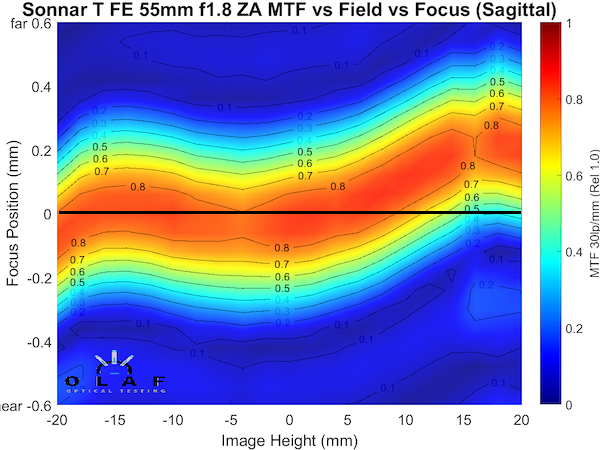
Olaf Optical Testing, 2016
The tilt in the field of focus may well be a deal breaker for you if you’re doing a type of photography that requires both edges to be equally sharp in the same plane. But it also might not make you much difference at all.
Remember that for many lenses the field of focus is often not flat in either edge. This Zeiss Milvus 50mm f/2.0, for example, is not tilted at all, but the best focus for the edges is in quite a different position than the best focus for the center. It’s even and not tilted, but the field is certainly not flat. Yet people seem to like it.

Olaf Optical Testing, 2016
I understand that many of you will want to send that slightly tilted 55mm back and exchange it for another copy. Most of you, though, if you had never taken that test chart or brick wall shot with it, would have found it a perfectly good lens.
Again, my point here is not to discourage you from taking test chart shots. Obviously, I think they are very useful things; I spend my days testing. But if you are going to shoot test targets, I think it’s important to know exactly what you are testing, and what might be causing your abnormal result. That 55mm lens above is a superb example of a lens that one photographer might might be perfectly happy with, while another finds it completely unacceptable. And a third never took an actual picture with it because it looked horrid on a test chart.
Let me be clear, the examples I showed above are all good lenses, with mild field tilts that are pretty reasonable. None of the ones I showed you were ‘ruin your photograph’ bad. They might ruin your test chart experience a bit if you don’t look a little more closely than just a center focused shot, though.
A lens like this one (which isn’t as rare as you might think) could be ‘ruin your photograph’ bad. Very severe field tilts like this can affect absolute sharpness, too. But this lens has both an unacceptable field tilt and a bit of decentering (notice the greatest sharpness is around -5mm from center).
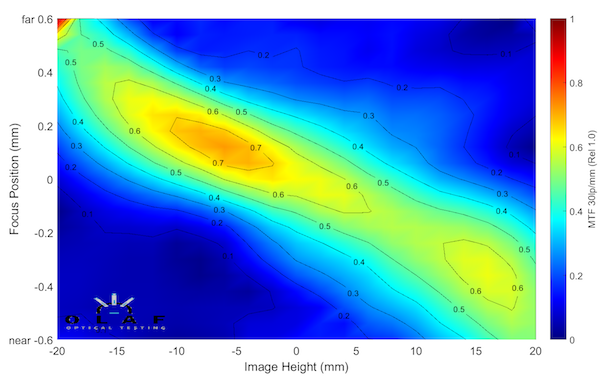
Olaf Optical Testing, 2016
By The Way – for anyone who is freaking out about the amount of field tilt in those prime lenses I’ve shown you, I’ll bet you there’s a lens in your bag with more tilt than any of those (except this last one). We call those lenses with lots of field tilts zoom lenses.
So What is the Takeaway Lesson?
If you take a test picture of a chart or a brick wall and see one side or one corner is a soft you don’t know what you’ve seen. It takes just a second longer to refocus on that soft area and see if you can bring it into sharp focus. If you can, you’re probably dealing with a field of focus tilt, not a decentering of the lens. Field of focus tilt has less effect on image quality than decentering for most types of photography, and for some lenses a slight field tilt is the best copy you’re going to find.
You can quantitate it a bit too, although crudely, by looking at how different the focusing distance has to changed to get that area sharp. Even if the lens appears reasonably sharp on your test chart, you should still refocus on each side and see if they are even because the field of focus may be curved. When you are focused on the center neither side is expected to be in good focus.
Roger Cicala and Aaron Closz
Lensrentals.com
October, 2016
Addendum: The metrologists among you have probably realized that all the field-of-focus tests we’ve shown you are simply from one side to the other. For the best possible testing, we’d also want to look at top-to-bottom and perhaps even corner-to-corner testing of a lens. Or alternatively, do 4-rotation MTF curves to pick the angle most likely to have field of focus tilt.
Why don’t we do that? Because time takes time. Our automated system can run a 4-rotation MTF in 3 to 15 minutes depending on focal length (wider takes longer). Doing 4 rotations of field vs focus tests like this would take from 45 to 120 minutes. That makes it impractical for actual lens testing, except as a very high-dollar tests for specialty lenses or for investigation. But the principle is important because it is being used to design different machines that can measure both MTF and Field of Focus quickly. That type of testing will probably become the new gold standard of lens testing.
Author: Roger Cicala
I’m Roger and I am the founder of Lensrentals.com. Hailed as one of the optic nerds here, I enjoy shooting collimated light through 30X microscope objectives in my spare time. When I do take real pictures I like using something different: a Medium format, or Pentax K1, or a Sony RX1R.
-
Michael Clark
-
Roger Cicala
-
Michael Clark
-
Alec Kinnear
-
Tree Young
-
Héng Ji?ng
-
héng ji?ng
-
bdbender4
-
pest
-
Roger Cicala
-
Brandon Dube
-
Ralph Hightower
-
Roger Cicala
-
Shane
-
Roger Cicala
-
Brandon Dube
-
Roger Cicala
-
Claudia Muster
-
David
-
obican
-
Roger Cicala
-
Lee
-
Lee
-
Athanasius Kirchner
-
Mike Aubrey
-
Roger Cicala
-
Stanislaw Zolczynski
-
Roger Cicala
-
Frans van den Bergh
-
obican
